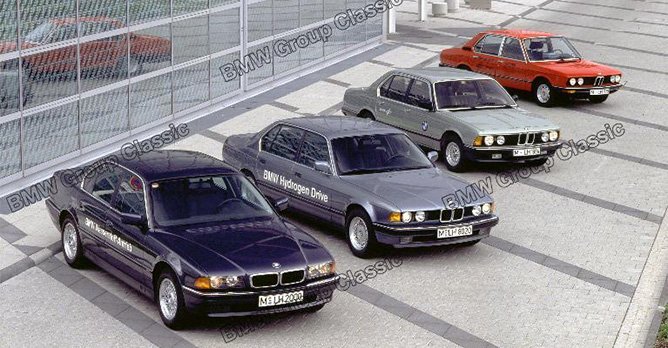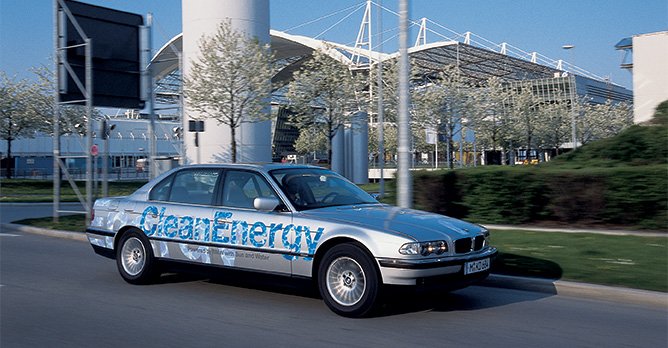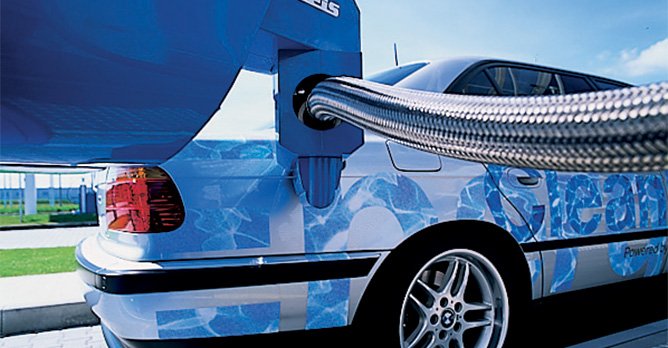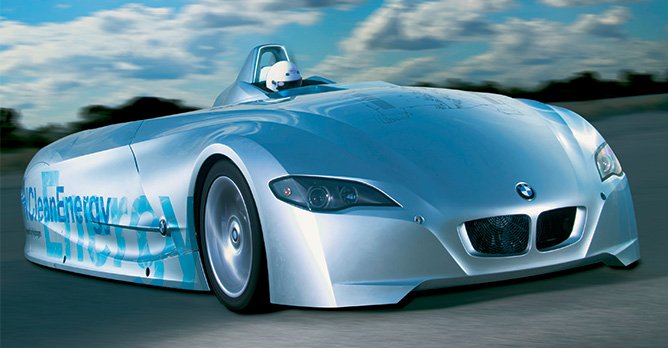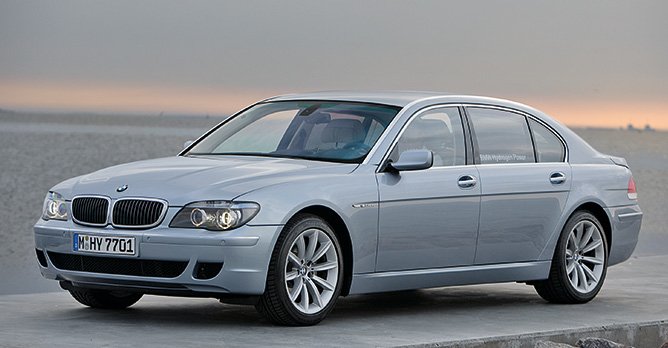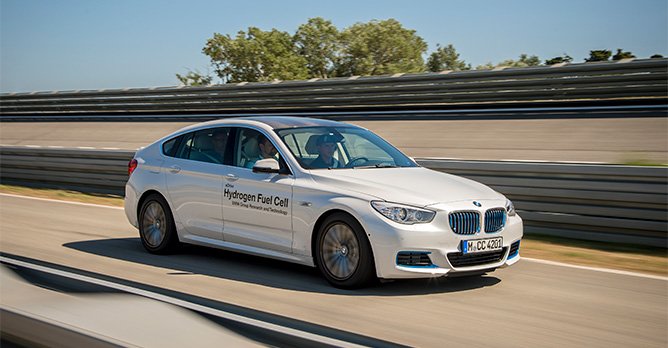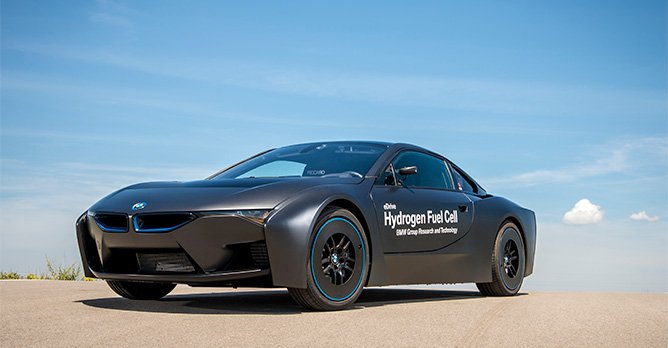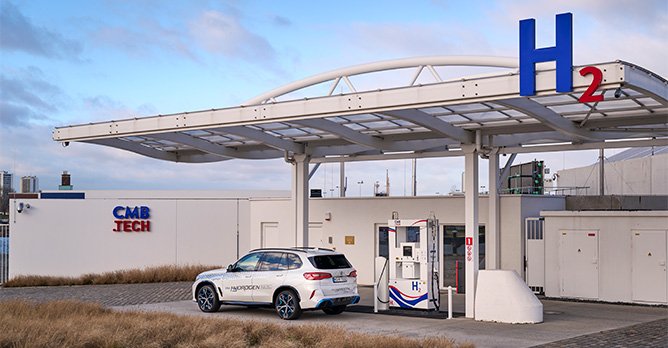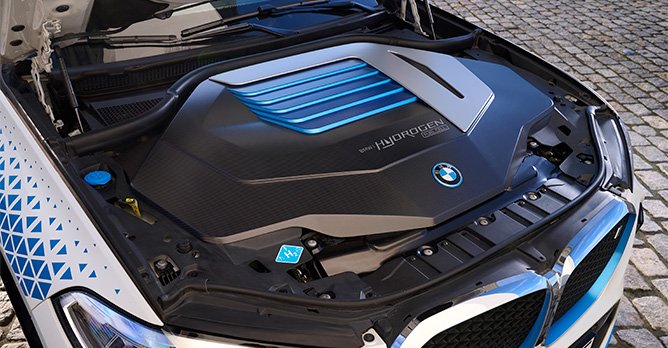History in hydrogen: Every hydrogen-powered car we know BMW has made so far
14 Mar 2023|3,036 views
"The hydrogen era has begun." You'd be forgiven for thinking this statement kicks off the press release of the BMW iX5 Hydrogen we recently got the chance to drive, but you'll have to let your mind travel further back in time to picture the actual car in question.
And we mean quite far back in time - because this throat-clearing statement was made all the way back in 2001, for what BMW had already dubbed its "first series production hydrogen car": The E38 BMW 750hL. Yet even this, however, wasn't the first known car to be powered by the still niche-skewing energy source in the firm's history...
1. The concepts: BMW 520h (E12), BMW 735i Hydrogen Drive (E23), BMW 735i Hydrogen Drive (E32) - 1979 to 1994
Just seven years after BMW swapped the four-cylinder engine of the 1602 Sedan out for battery packs and an electric motor during the Munich Olympics, it was also already starting to preview another alternative to the petrol/diesel combustion engine.
A dual fuel variant of the E12 5 Series, called the 520h, marked the first known introduction of hydrogen to the firm. Equipped with a 3.5-litre direct injection engine, the sedan could run on gasoline as other E12s did, but was also equipped with super insulated cryogenic tanks that stored liquid hydrogen.
There is little that we can find now about the exact specifications of these one-off concept cars. But starting with the 520h, efforts continued down this path of offering dual power sources in a car. BMW's attention also started to shift towards its flagship 7 Series along the way, with efforts culminating in the E32 735i Hydrogen Drive in 1994.
Worth noting is that up to this point, all of the cars had been one-offs, and officially designated as 'research vehicles'.
2. BMW 750hL (E38) - 2000
21 years after its first research vehicle was unveiled, BMW had reached a new milestone. The confidence with which the company approached the 750hL is most evident not just in its declaration of a new hydrogen era mentioned above, but the fact that it went as far as to call the sedan "the world's first series production hydrogen car".
Moving up from one-off concept cars, 15 units of the 750hL were produced this time round - in other words, a proper fleet - and went into service immediately as shuttles for guests of the EXPO 2000, held in Hannover.
Built on the long-wheelbase variant of the E38 7 Series, the 750hL boasted a 12-cylinder combustion engine that could run on either petrol or superchilled liquid hydrogen, stored at around minus 250°C in a double-walled steel tank behind the rear seat-backs.
Performance was already quite impressive here; when running on hydrogen the engine was able to deliver 204bhp and bring the car to 100km/h from rest in under 10 seconds, before going on to help it hit a maximum speed of 226km/h. The hydrogen tank also gave the car an extra 350km in range.
As its first broad(er) stab at translating the energy source into use on our roads, BMW considered the 750hL a success; the fleet had cumulatively clocked 100,000km of mileage within six months with no reported issues. Still, there's no denying that this remained an outing of rather limited scale.
3. BMW H2R - 2004
It was clear from its aerodynamically-informed silhouette that you'd never see the H2R parked in your neighbour's garage. Nonetheless, the vehicle, which served as a preview for a very important name in BMW's hydrogen timeline (we're getting to it), was also fascinating for the promises of performance that it held with regards to hydrogen.
Power came from a derivative of the 6.0-litre, 12-cylinder combustion engine from the E65 BMW 760i that produced 285bhp - significantly more than that in the 750hL. It also brought with it the most advanced technologies from BMW at that point, including its fully variable 'VALVETRONIC' valve drive.
Built to be lightweight, the H2R rocketed to 100km/h in just six seconds (keep this figure in mind), before going on to reach a top speed of 300km/h. It confidently rose to the occasion when getting put through its paces during testing, logging nine FIA-ratified speed records for hydrogen-powered vehicles in the process.
4. BMW Hydrogen 7 (E68) - 2006
Before the iX5 Hydrogen finally made its official debut, most people would have traced BMW's most recent efforts in the arena of hydrogen to yet another retooled variant of its flagship sedan: The Hydrogen 7.
In case you're wondering - no, there hasn't been a mistake with the car's stated internal model code. Built on the 760Li, the Hydrogen 7 was treated as its own series production model, and also boasted a 6.0-litre V12 engine producing 256bhp, albeit a bivalent one that could run on both gasoline and liquefied hydrogen.
The stakes were escalated this time, with a far larger fleet of 100 cars produced in comparison to the 15 for the 750hL. After its official launch at the 2006 L.A. Motorshow (fun fact - it shared the stage with the second-generation X5 there), the Hydrogen 7 would go on to be offered to selected users through 2007, including high-profile politicians, industry leaders and celebrities.
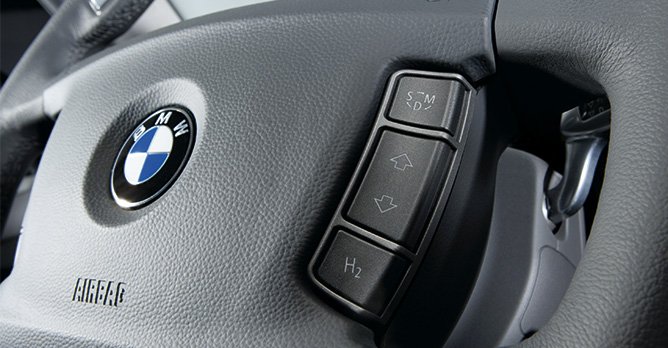
 That H2 button on the car's steering wheel allowed a driver to switch between hydrogen and gasoline power A key feature of the Hydrogen 7 was its dual-mode power unit (the driver would have seen a special button on their steering wheel) which could switch quickly between running on either hydrogen and gasoline. While the combination of both hydrogen and gasoline fuel tanks gave it an impressive cruising range of over 640km, the car also weighed 250kg more than the standard 760Li.
That H2 button on the car's steering wheel allowed a driver to switch between hydrogen and gasoline power A key feature of the Hydrogen 7 was its dual-mode power unit (the driver would have seen a special button on their steering wheel) which could switch quickly between running on either hydrogen and gasoline. While the combination of both hydrogen and gasoline fuel tanks gave it an impressive cruising range of over 640km, the car also weighed 250kg more than the standard 760Li.
The longer-term feasibility of the Hydrogen 7, nonetheless, started to be put into question not long after its debut. For starters, the differing energy densities between gasoline fuel and liquid hydrogen meant that its consumption figures when running on the latter were far from efficient.
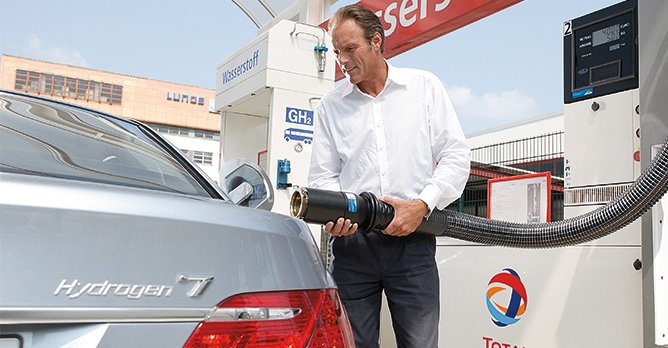
 Having to store the hydrogen in liquefied form ultimately proved to be unsustainable in the long run Additionally, storing hydrogen in liquid form required it to be kept at a (literally) cool -253°C constantly - which was impossible to achieve over longer periods; any warmer, and it would start to vaporise and have to be released from the tank. This occurred in spite of the tank's double-walling, and the high-vacuum storage conditions. A report by Wired Magazine back in the day noted that this would start around 17 hours after the car had been stationarily parked, with the final outcome being that the tank would be emptied out between 10 to 12 days.
Having to store the hydrogen in liquefied form ultimately proved to be unsustainable in the long run Additionally, storing hydrogen in liquid form required it to be kept at a (literally) cool -253°C constantly - which was impossible to achieve over longer periods; any warmer, and it would start to vaporise and have to be released from the tank. This occurred in spite of the tank's double-walling, and the high-vacuum storage conditions. A report by Wired Magazine back in the day noted that this would start around 17 hours after the car had been stationarily parked, with the final outcome being that the tank would be emptied out between 10 to 12 days.
BMW never gave an official word on where developments from the Hydrogen 7 led, but tellingly, the car would be its last high profile involvement with the hydrogen combustion engine.
5. BMW 5 Series GT FCEV (and 'BMW i8 Hydrogen') - 2015
A 2013 technical partnership between BMW and Toyota Motor Corporation for the sourcing of individual fuel cells from the latter set the stage for what was to come two years later - and for what has continued till today.
Nearly a decade after the BMW Hydrogen 7 had been sent out into the hands of a lucky few (or hundred) around the world, the reappearance of a hydrogen-powered vehicle took on a vastly different angle: Unveiled at the 2015 BMW Group Innovation Days was a very unique 5 Series Gran Turismo that featured a fuel cell drive system in place of a combustion engine.
Unlike the 750hL and Hydrogen 7, the 5 Series GT prototype was now undoubtedly an electric vehicle - a fuel cell electric one (FCEV) that boasted a maximum output of 180kW (241bhp) and could do the century sprint in 8.8 seconds, yet have a range of over 500km and refilling time of just four minutes.
More importantly, its existence was a reflection of the changing times, drawing from the strengths of both BMW's work with Toyota, as well as the firm's maturing eDrive technology.
While still designated officially as a 'demonstration vehicle' back then, much of what was showcased in the 5 Series GT FCEV previewed what was to come in the iX5 Hydrogen. A tunnel tank between the front and rear axles helped with storing the compressed hydrogen at a pressure of 350 bar. The fuel cell system was also housed at the front - where the engine would have been - while an electric motor from BMW i sat on the rear axle.
(The other star of the BMW Group Innovation Days 2015 was a car that looked like something Batman might drive - if climate change was also something he wanted to fight alongside psychopaths and criminals. This vehicle, built with the i8 as its base, had apparently already been undergoing testing since 2012.)
6. BMW iX5 Hydrogen - 2023
The hydrogen story now continues with the recent 'launch' of the iX5 Hydrogen onto the road worldwide. Officially, less than 100 cars count to the pilot fleet - around the same size as that of the Hydrogen 7 - which will traverse the world to reach countries such as the U.S.A, China and Japan (we attended the inaugural drive for members of the media in Antwerp, Belgium).
Now firmly rooted within and aligned with the BMW i brand, the iX5 Hydrogen taps on strengths of its growing expertise with battery electric vehicles (BEVs) to preview what production FCEVs from BMW can be like.
Among the car's feats is a fuel cell system that is claimed to be the most powerful ever for a passenger vehicle in the world, capable of producing 125kW (168bhp) on its continuously. The SUV also gets the same electric motor from the iX, rated at 295kW (396bhp) and 710Nm of torque, thus allowing it to complete the century sprint in under six seconds… or around the same time as the H2R.
In similar fashion to how combusting hydrogen was seen as a promising alternative to combusting gasoline, BMW believes FCEVs can be developed in tandem with BEVs towards the same goal of reducing emissions especially considering the unique benefits they offer.
With investments in green hydrogen finally appearing to take flight now, the firm has even declared that a production car could hit the market in the later half of this decade - although this is likely to be seen on a larger model.
Here are a few other stories which may interest you!
Another element of electromobility: Why BMW is throwing its weight behind hydrogen power now
What's next for better, cleaner energy? A quick rundown of everything we should watch out for in 2023
FROM THE ELiXIR OF i: Luxury finds new meaning with BMW's electrification
BMW flagships: The circularity of luxury, today and beyond
And we mean quite far back in time - because this throat-clearing statement was made all the way back in 2001, for what BMW had already dubbed its "first series production hydrogen car": The E38 BMW 750hL. Yet even this, however, wasn't the first known car to be powered by the still niche-skewing energy source in the firm's history...
1. The concepts: BMW 520h (E12), BMW 735i Hydrogen Drive (E23), BMW 735i Hydrogen Drive (E32) - 1979 to 1994
Just seven years after BMW swapped the four-cylinder engine of the 1602 Sedan out for battery packs and an electric motor during the Munich Olympics, it was also already starting to preview another alternative to the petrol/diesel combustion engine.
A dual fuel variant of the E12 5 Series, called the 520h, marked the first known introduction of hydrogen to the firm. Equipped with a 3.5-litre direct injection engine, the sedan could run on gasoline as other E12s did, but was also equipped with super insulated cryogenic tanks that stored liquid hydrogen.
There is little that we can find now about the exact specifications of these one-off concept cars. But starting with the 520h, efforts continued down this path of offering dual power sources in a car. BMW's attention also started to shift towards its flagship 7 Series along the way, with efforts culminating in the E32 735i Hydrogen Drive in 1994.
Worth noting is that up to this point, all of the cars had been one-offs, and officially designated as 'research vehicles'.
2. BMW 750hL (E38) - 2000
21 years after its first research vehicle was unveiled, BMW had reached a new milestone. The confidence with which the company approached the 750hL is most evident not just in its declaration of a new hydrogen era mentioned above, but the fact that it went as far as to call the sedan "the world's first series production hydrogen car".
Moving up from one-off concept cars, 15 units of the 750hL were produced this time round - in other words, a proper fleet - and went into service immediately as shuttles for guests of the EXPO 2000, held in Hannover.
Built on the long-wheelbase variant of the E38 7 Series, the 750hL boasted a 12-cylinder combustion engine that could run on either petrol or superchilled liquid hydrogen, stored at around minus 250°C in a double-walled steel tank behind the rear seat-backs.
Performance was already quite impressive here; when running on hydrogen the engine was able to deliver 204bhp and bring the car to 100km/h from rest in under 10 seconds, before going on to help it hit a maximum speed of 226km/h. The hydrogen tank also gave the car an extra 350km in range.
As its first broad(er) stab at translating the energy source into use on our roads, BMW considered the 750hL a success; the fleet had cumulatively clocked 100,000km of mileage within six months with no reported issues. Still, there's no denying that this remained an outing of rather limited scale.
3. BMW H2R - 2004
It was clear from its aerodynamically-informed silhouette that you'd never see the H2R parked in your neighbour's garage. Nonetheless, the vehicle, which served as a preview for a very important name in BMW's hydrogen timeline (we're getting to it), was also fascinating for the promises of performance that it held with regards to hydrogen.
Power came from a derivative of the 6.0-litre, 12-cylinder combustion engine from the E65 BMW 760i that produced 285bhp - significantly more than that in the 750hL. It also brought with it the most advanced technologies from BMW at that point, including its fully variable 'VALVETRONIC' valve drive.
Built to be lightweight, the H2R rocketed to 100km/h in just six seconds (keep this figure in mind), before going on to reach a top speed of 300km/h. It confidently rose to the occasion when getting put through its paces during testing, logging nine FIA-ratified speed records for hydrogen-powered vehicles in the process.
4. BMW Hydrogen 7 (E68) - 2006
Before the iX5 Hydrogen finally made its official debut, most people would have traced BMW's most recent efforts in the arena of hydrogen to yet another retooled variant of its flagship sedan: The Hydrogen 7.
In case you're wondering - no, there hasn't been a mistake with the car's stated internal model code. Built on the 760Li, the Hydrogen 7 was treated as its own series production model, and also boasted a 6.0-litre V12 engine producing 256bhp, albeit a bivalent one that could run on both gasoline and liquefied hydrogen.
The stakes were escalated this time, with a far larger fleet of 100 cars produced in comparison to the 15 for the 750hL. After its official launch at the 2006 L.A. Motorshow (fun fact - it shared the stage with the second-generation X5 there), the Hydrogen 7 would go on to be offered to selected users through 2007, including high-profile politicians, industry leaders and celebrities.

The longer-term feasibility of the Hydrogen 7, nonetheless, started to be put into question not long after its debut. For starters, the differing energy densities between gasoline fuel and liquid hydrogen meant that its consumption figures when running on the latter were far from efficient.

BMW never gave an official word on where developments from the Hydrogen 7 led, but tellingly, the car would be its last high profile involvement with the hydrogen combustion engine.
5. BMW 5 Series GT FCEV (and 'BMW i8 Hydrogen') - 2015
A 2013 technical partnership between BMW and Toyota Motor Corporation for the sourcing of individual fuel cells from the latter set the stage for what was to come two years later - and for what has continued till today.
Nearly a decade after the BMW Hydrogen 7 had been sent out into the hands of a lucky few (or hundred) around the world, the reappearance of a hydrogen-powered vehicle took on a vastly different angle: Unveiled at the 2015 BMW Group Innovation Days was a very unique 5 Series Gran Turismo that featured a fuel cell drive system in place of a combustion engine.
Unlike the 750hL and Hydrogen 7, the 5 Series GT prototype was now undoubtedly an electric vehicle - a fuel cell electric one (FCEV) that boasted a maximum output of 180kW (241bhp) and could do the century sprint in 8.8 seconds, yet have a range of over 500km and refilling time of just four minutes.
More importantly, its existence was a reflection of the changing times, drawing from the strengths of both BMW's work with Toyota, as well as the firm's maturing eDrive technology.
While still designated officially as a 'demonstration vehicle' back then, much of what was showcased in the 5 Series GT FCEV previewed what was to come in the iX5 Hydrogen. A tunnel tank between the front and rear axles helped with storing the compressed hydrogen at a pressure of 350 bar. The fuel cell system was also housed at the front - where the engine would have been - while an electric motor from BMW i sat on the rear axle.
(The other star of the BMW Group Innovation Days 2015 was a car that looked like something Batman might drive - if climate change was also something he wanted to fight alongside psychopaths and criminals. This vehicle, built with the i8 as its base, had apparently already been undergoing testing since 2012.)
6. BMW iX5 Hydrogen - 2023
The hydrogen story now continues with the recent 'launch' of the iX5 Hydrogen onto the road worldwide. Officially, less than 100 cars count to the pilot fleet - around the same size as that of the Hydrogen 7 - which will traverse the world to reach countries such as the U.S.A, China and Japan (we attended the inaugural drive for members of the media in Antwerp, Belgium).
Now firmly rooted within and aligned with the BMW i brand, the iX5 Hydrogen taps on strengths of its growing expertise with battery electric vehicles (BEVs) to preview what production FCEVs from BMW can be like.
Among the car's feats is a fuel cell system that is claimed to be the most powerful ever for a passenger vehicle in the world, capable of producing 125kW (168bhp) on its continuously. The SUV also gets the same electric motor from the iX, rated at 295kW (396bhp) and 710Nm of torque, thus allowing it to complete the century sprint in under six seconds… or around the same time as the H2R.
In similar fashion to how combusting hydrogen was seen as a promising alternative to combusting gasoline, BMW believes FCEVs can be developed in tandem with BEVs towards the same goal of reducing emissions especially considering the unique benefits they offer.
With investments in green hydrogen finally appearing to take flight now, the firm has even declared that a production car could hit the market in the later half of this decade - although this is likely to be seen on a larger model.
Here are a few other stories which may interest you!
Another element of electromobility: Why BMW is throwing its weight behind hydrogen power now
What's next for better, cleaner energy? A quick rundown of everything we should watch out for in 2023
FROM THE ELiXIR OF i: Luxury finds new meaning with BMW's electrification
BMW flagships: The circularity of luxury, today and beyond
"The hydrogen era has begun." You'd be forgiven for thinking this statement kicks off the press release of the BMW iX5 Hydrogen we recently got the chance to drive, but you'll have to let your mind travel further back in time to picture the actual car in question.
And we mean quite far back in time - because this throat-clearing statement was made all the way back in 2001, for what BMW had already dubbed its "first series production hydrogen car": The E38 BMW 750hL. Yet even this, however, wasn't the first known car to be powered by the still niche-skewing energy source in the firm's history...
1. The concepts: BMW 520h (E12), BMW 735i Hydrogen Drive (E23), BMW 735i Hydrogen Drive (E32) - 1979 to 1994
Just seven years after BMW swapped the four-cylinder engine of the 1602 Sedan out for battery packs and an electric motor during the Munich Olympics, it was also already starting to preview another alternative to the petrol/diesel combustion engine.
A dual fuel variant of the E12 5 Series, called the 520h, marked the first known introduction of hydrogen to the firm. Equipped with a 3.5-litre direct injection engine, the sedan could run on gasoline as other E12s did, but was also equipped with super insulated cryogenic tanks that stored liquid hydrogen.
There is little that we can find now about the exact specifications of these one-off concept cars. But starting with the 520h, efforts continued down this path of offering dual power sources in a car. BMW's attention also started to shift towards its flagship 7 Series along the way, with efforts culminating in the E32 735i Hydrogen Drive in 1994.
Worth noting is that up to this point, all of the cars had been one-offs, and officially designated as 'research vehicles'.
2. BMW 750hL (E38) - 2000
21 years after its first research vehicle was unveiled, BMW had reached a new milestone. The confidence with which the company approached the 750hL is most evident not just in its declaration of a new hydrogen era mentioned above, but the fact that it went as far as to call the sedan "the world's first series production hydrogen car".
Moving up from one-off concept cars, 15 units of the 750hL were produced this time round - in other words, a proper fleet - and went into service immediately as shuttles for guests of the EXPO 2000, held in Hannover.
Built on the long-wheelbase variant of the E38 7 Series, the 750hL boasted a 12-cylinder combustion engine that could run on either petrol or superchilled liquid hydrogen, stored at around minus 250°C in a double-walled steel tank behind the rear seat-backs.
Performance was already quite impressive here; when running on hydrogen the engine was able to deliver 204bhp and bring the car to 100km/h from rest in under 10 seconds, before going on to help it hit a maximum speed of 226km/h. The hydrogen tank also gave the car an extra 350km in range.
As its first broad(er) stab at translating the energy source into use on our roads, BMW considered the 750hL a success; the fleet had cumulatively clocked 100,000km of mileage within six months with no reported issues. Still, there's no denying that this remained an outing of rather limited scale.
3. BMW H2R - 2004
It was clear from its aerodynamically-informed silhouette that you'd never see the H2R parked in your neighbour's garage. Nonetheless, the vehicle, which served as a preview for a very important name in BMW's hydrogen timeline (we're getting to it), was also fascinating for the promises of performance that it held with regards to hydrogen.
Power came from a derivative of the 6.0-litre, 12-cylinder combustion engine from the E65 BMW 760i that produced 285bhp - significantly more than that in the 750hL. It also brought with it the most advanced technologies from BMW at that point, including its fully variable 'VALVETRONIC' valve drive.
Built to be lightweight, the H2R rocketed to 100km/h in just six seconds (keep this figure in mind), before going on to reach a top speed of 300km/h. It confidently rose to the occasion when getting put through its paces during testing, logging nine FIA-ratified speed records for hydrogen-powered vehicles in the process.
4. BMW Hydrogen 7 (E68) - 2006
Before the iX5 Hydrogen finally made its official debut, most people would have traced BMW's most recent efforts in the arena of hydrogen to yet another retooled variant of its flagship sedan: The Hydrogen 7.
In case you're wondering - no, there hasn't been a mistake with the car's stated internal model code. Built on the 760Li, the Hydrogen 7 was treated as its own series production model, and also boasted a 6.0-litre V12 engine producing 256bhp, albeit a bivalent one that could run on both gasoline and liquefied hydrogen.
The stakes were escalated this time, with a far larger fleet of 100 cars produced in comparison to the 15 for the 750hL. After its official launch at the 2006 L.A. Motorshow (fun fact - it shared the stage with the second-generation X5 there), the Hydrogen 7 would go on to be offered to selected users through 2007, including high-profile politicians, industry leaders and celebrities.

 That H2 button on the car's steering wheel allowed a driver to switch between hydrogen and gasoline power A key feature of the Hydrogen 7 was its dual-mode power unit (the driver would have seen a special button on their steering wheel) which could switch quickly between running on either hydrogen and gasoline. While the combination of both hydrogen and gasoline fuel tanks gave it an impressive cruising range of over 640km, the car also weighed 250kg more than the standard 760Li.
That H2 button on the car's steering wheel allowed a driver to switch between hydrogen and gasoline power A key feature of the Hydrogen 7 was its dual-mode power unit (the driver would have seen a special button on their steering wheel) which could switch quickly between running on either hydrogen and gasoline. While the combination of both hydrogen and gasoline fuel tanks gave it an impressive cruising range of over 640km, the car also weighed 250kg more than the standard 760Li.
The longer-term feasibility of the Hydrogen 7, nonetheless, started to be put into question not long after its debut. For starters, the differing energy densities between gasoline fuel and liquid hydrogen meant that its consumption figures when running on the latter were far from efficient.

 Having to store the hydrogen in liquefied form ultimately proved to be unsustainable in the long run Additionally, storing hydrogen in liquid form required it to be kept at a (literally) cool -253°C constantly - which was impossible to achieve over longer periods; any warmer, and it would start to vaporise and have to be released from the tank. This occurred in spite of the tank's double-walling, and the high-vacuum storage conditions. A report by Wired Magazine back in the day noted that this would start around 17 hours after the car had been stationarily parked, with the final outcome being that the tank would be emptied out between 10 to 12 days.
Having to store the hydrogen in liquefied form ultimately proved to be unsustainable in the long run Additionally, storing hydrogen in liquid form required it to be kept at a (literally) cool -253°C constantly - which was impossible to achieve over longer periods; any warmer, and it would start to vaporise and have to be released from the tank. This occurred in spite of the tank's double-walling, and the high-vacuum storage conditions. A report by Wired Magazine back in the day noted that this would start around 17 hours after the car had been stationarily parked, with the final outcome being that the tank would be emptied out between 10 to 12 days.
BMW never gave an official word on where developments from the Hydrogen 7 led, but tellingly, the car would be its last high profile involvement with the hydrogen combustion engine.
5. BMW 5 Series GT FCEV (and 'BMW i8 Hydrogen') - 2015
A 2013 technical partnership between BMW and Toyota Motor Corporation for the sourcing of individual fuel cells from the latter set the stage for what was to come two years later - and for what has continued till today.
Nearly a decade after the BMW Hydrogen 7 had been sent out into the hands of a lucky few (or hundred) around the world, the reappearance of a hydrogen-powered vehicle took on a vastly different angle: Unveiled at the 2015 BMW Group Innovation Days was a very unique 5 Series Gran Turismo that featured a fuel cell drive system in place of a combustion engine.
Unlike the 750hL and Hydrogen 7, the 5 Series GT prototype was now undoubtedly an electric vehicle - a fuel cell electric one (FCEV) that boasted a maximum output of 180kW (241bhp) and could do the century sprint in 8.8 seconds, yet have a range of over 500km and refilling time of just four minutes.
More importantly, its existence was a reflection of the changing times, drawing from the strengths of both BMW's work with Toyota, as well as the firm's maturing eDrive technology.
While still designated officially as a 'demonstration vehicle' back then, much of what was showcased in the 5 Series GT FCEV previewed what was to come in the iX5 Hydrogen. A tunnel tank between the front and rear axles helped with storing the compressed hydrogen at a pressure of 350 bar. The fuel cell system was also housed at the front - where the engine would have been - while an electric motor from BMW i sat on the rear axle.
(The other star of the BMW Group Innovation Days 2015 was a car that looked like something Batman might drive - if climate change was also something he wanted to fight alongside psychopaths and criminals. This vehicle, built with the i8 as its base, had apparently already been undergoing testing since 2012.)
6. BMW iX5 Hydrogen - 2023
The hydrogen story now continues with the recent 'launch' of the iX5 Hydrogen onto the road worldwide. Officially, less than 100 cars count to the pilot fleet - around the same size as that of the Hydrogen 7 - which will traverse the world to reach countries such as the U.S.A, China and Japan (we attended the inaugural drive for members of the media in Antwerp, Belgium).
Now firmly rooted within and aligned with the BMW i brand, the iX5 Hydrogen taps on strengths of its growing expertise with battery electric vehicles (BEVs) to preview what production FCEVs from BMW can be like.
Among the car's feats is a fuel cell system that is claimed to be the most powerful ever for a passenger vehicle in the world, capable of producing 125kW (168bhp) on its continuously. The SUV also gets the same electric motor from the iX, rated at 295kW (396bhp) and 710Nm of torque, thus allowing it to complete the century sprint in under six seconds… or around the same time as the H2R.
In similar fashion to how combusting hydrogen was seen as a promising alternative to combusting gasoline, BMW believes FCEVs can be developed in tandem with BEVs towards the same goal of reducing emissions especially considering the unique benefits they offer.
With investments in green hydrogen finally appearing to take flight now, the firm has even declared that a production car could hit the market in the later half of this decade - although this is likely to be seen on a larger model.
Here are a few other stories which may interest you!
Another element of electromobility: Why BMW is throwing its weight behind hydrogen power now
What's next for better, cleaner energy? A quick rundown of everything we should watch out for in 2023
FROM THE ELiXIR OF i: Luxury finds new meaning with BMW's electrification
BMW flagships: The circularity of luxury, today and beyond
And we mean quite far back in time - because this throat-clearing statement was made all the way back in 2001, for what BMW had already dubbed its "first series production hydrogen car": The E38 BMW 750hL. Yet even this, however, wasn't the first known car to be powered by the still niche-skewing energy source in the firm's history...
1. The concepts: BMW 520h (E12), BMW 735i Hydrogen Drive (E23), BMW 735i Hydrogen Drive (E32) - 1979 to 1994
Just seven years after BMW swapped the four-cylinder engine of the 1602 Sedan out for battery packs and an electric motor during the Munich Olympics, it was also already starting to preview another alternative to the petrol/diesel combustion engine.
A dual fuel variant of the E12 5 Series, called the 520h, marked the first known introduction of hydrogen to the firm. Equipped with a 3.5-litre direct injection engine, the sedan could run on gasoline as other E12s did, but was also equipped with super insulated cryogenic tanks that stored liquid hydrogen.
There is little that we can find now about the exact specifications of these one-off concept cars. But starting with the 520h, efforts continued down this path of offering dual power sources in a car. BMW's attention also started to shift towards its flagship 7 Series along the way, with efforts culminating in the E32 735i Hydrogen Drive in 1994.
Worth noting is that up to this point, all of the cars had been one-offs, and officially designated as 'research vehicles'.
2. BMW 750hL (E38) - 2000
21 years after its first research vehicle was unveiled, BMW had reached a new milestone. The confidence with which the company approached the 750hL is most evident not just in its declaration of a new hydrogen era mentioned above, but the fact that it went as far as to call the sedan "the world's first series production hydrogen car".
Moving up from one-off concept cars, 15 units of the 750hL were produced this time round - in other words, a proper fleet - and went into service immediately as shuttles for guests of the EXPO 2000, held in Hannover.
Built on the long-wheelbase variant of the E38 7 Series, the 750hL boasted a 12-cylinder combustion engine that could run on either petrol or superchilled liquid hydrogen, stored at around minus 250°C in a double-walled steel tank behind the rear seat-backs.
Performance was already quite impressive here; when running on hydrogen the engine was able to deliver 204bhp and bring the car to 100km/h from rest in under 10 seconds, before going on to help it hit a maximum speed of 226km/h. The hydrogen tank also gave the car an extra 350km in range.
As its first broad(er) stab at translating the energy source into use on our roads, BMW considered the 750hL a success; the fleet had cumulatively clocked 100,000km of mileage within six months with no reported issues. Still, there's no denying that this remained an outing of rather limited scale.
3. BMW H2R - 2004
It was clear from its aerodynamically-informed silhouette that you'd never see the H2R parked in your neighbour's garage. Nonetheless, the vehicle, which served as a preview for a very important name in BMW's hydrogen timeline (we're getting to it), was also fascinating for the promises of performance that it held with regards to hydrogen.
Power came from a derivative of the 6.0-litre, 12-cylinder combustion engine from the E65 BMW 760i that produced 285bhp - significantly more than that in the 750hL. It also brought with it the most advanced technologies from BMW at that point, including its fully variable 'VALVETRONIC' valve drive.
Built to be lightweight, the H2R rocketed to 100km/h in just six seconds (keep this figure in mind), before going on to reach a top speed of 300km/h. It confidently rose to the occasion when getting put through its paces during testing, logging nine FIA-ratified speed records for hydrogen-powered vehicles in the process.
4. BMW Hydrogen 7 (E68) - 2006
Before the iX5 Hydrogen finally made its official debut, most people would have traced BMW's most recent efforts in the arena of hydrogen to yet another retooled variant of its flagship sedan: The Hydrogen 7.
In case you're wondering - no, there hasn't been a mistake with the car's stated internal model code. Built on the 760Li, the Hydrogen 7 was treated as its own series production model, and also boasted a 6.0-litre V12 engine producing 256bhp, albeit a bivalent one that could run on both gasoline and liquefied hydrogen.
The stakes were escalated this time, with a far larger fleet of 100 cars produced in comparison to the 15 for the 750hL. After its official launch at the 2006 L.A. Motorshow (fun fact - it shared the stage with the second-generation X5 there), the Hydrogen 7 would go on to be offered to selected users through 2007, including high-profile politicians, industry leaders and celebrities.

The longer-term feasibility of the Hydrogen 7, nonetheless, started to be put into question not long after its debut. For starters, the differing energy densities between gasoline fuel and liquid hydrogen meant that its consumption figures when running on the latter were far from efficient.

BMW never gave an official word on where developments from the Hydrogen 7 led, but tellingly, the car would be its last high profile involvement with the hydrogen combustion engine.
5. BMW 5 Series GT FCEV (and 'BMW i8 Hydrogen') - 2015
A 2013 technical partnership between BMW and Toyota Motor Corporation for the sourcing of individual fuel cells from the latter set the stage for what was to come two years later - and for what has continued till today.
Nearly a decade after the BMW Hydrogen 7 had been sent out into the hands of a lucky few (or hundred) around the world, the reappearance of a hydrogen-powered vehicle took on a vastly different angle: Unveiled at the 2015 BMW Group Innovation Days was a very unique 5 Series Gran Turismo that featured a fuel cell drive system in place of a combustion engine.
Unlike the 750hL and Hydrogen 7, the 5 Series GT prototype was now undoubtedly an electric vehicle - a fuel cell electric one (FCEV) that boasted a maximum output of 180kW (241bhp) and could do the century sprint in 8.8 seconds, yet have a range of over 500km and refilling time of just four minutes.
More importantly, its existence was a reflection of the changing times, drawing from the strengths of both BMW's work with Toyota, as well as the firm's maturing eDrive technology.
While still designated officially as a 'demonstration vehicle' back then, much of what was showcased in the 5 Series GT FCEV previewed what was to come in the iX5 Hydrogen. A tunnel tank between the front and rear axles helped with storing the compressed hydrogen at a pressure of 350 bar. The fuel cell system was also housed at the front - where the engine would have been - while an electric motor from BMW i sat on the rear axle.
(The other star of the BMW Group Innovation Days 2015 was a car that looked like something Batman might drive - if climate change was also something he wanted to fight alongside psychopaths and criminals. This vehicle, built with the i8 as its base, had apparently already been undergoing testing since 2012.)
6. BMW iX5 Hydrogen - 2023
The hydrogen story now continues with the recent 'launch' of the iX5 Hydrogen onto the road worldwide. Officially, less than 100 cars count to the pilot fleet - around the same size as that of the Hydrogen 7 - which will traverse the world to reach countries such as the U.S.A, China and Japan (we attended the inaugural drive for members of the media in Antwerp, Belgium).
Now firmly rooted within and aligned with the BMW i brand, the iX5 Hydrogen taps on strengths of its growing expertise with battery electric vehicles (BEVs) to preview what production FCEVs from BMW can be like.
Among the car's feats is a fuel cell system that is claimed to be the most powerful ever for a passenger vehicle in the world, capable of producing 125kW (168bhp) on its continuously. The SUV also gets the same electric motor from the iX, rated at 295kW (396bhp) and 710Nm of torque, thus allowing it to complete the century sprint in under six seconds… or around the same time as the H2R.
In similar fashion to how combusting hydrogen was seen as a promising alternative to combusting gasoline, BMW believes FCEVs can be developed in tandem with BEVs towards the same goal of reducing emissions especially considering the unique benefits they offer.
With investments in green hydrogen finally appearing to take flight now, the firm has even declared that a production car could hit the market in the later half of this decade - although this is likely to be seen on a larger model.
Here are a few other stories which may interest you!
Another element of electromobility: Why BMW is throwing its weight behind hydrogen power now
What's next for better, cleaner energy? A quick rundown of everything we should watch out for in 2023
FROM THE ELiXIR OF i: Luxury finds new meaning with BMW's electrification
BMW flagships: The circularity of luxury, today and beyond
Thank You For Your Subscription.


















